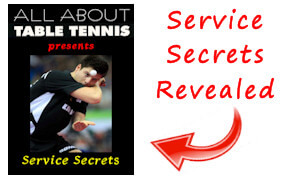You Are Here: Home » How to Play Table Tennis » Skill Tests
Table Tennis Skill
Do you need to improve your table tennis skill level?
Is it only juniors who can improve their skills? Find out here...
By Martin Hughes
Owner and Editor
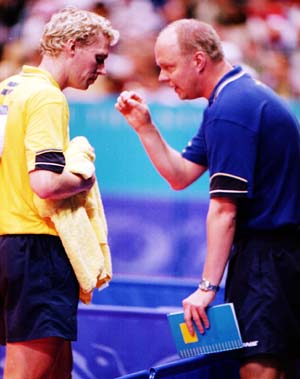 by courtesy of the ITTF
by courtesy of the ITTF
Improving your table tennis skill level. That should be the aim of every player.
I'd highly recommend getting some good table tennis coaching as early as possible in your playing career.
After all, if world class players need coaching, then you do too!
Table tennis coaching will help you to improve your skills and can be great fun too.
^ Top of page ^
TABLE TENNIS EXPERT
REVEALS HIS SECRETS
Click Here For Details
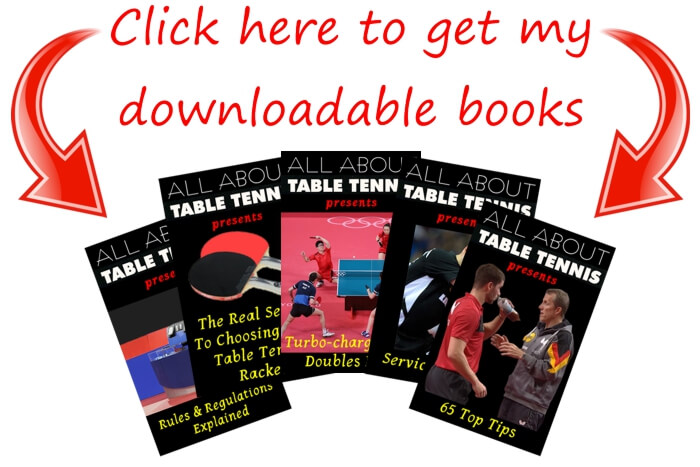
Click here for a large selection of
table tennis equipment at Megaspin *
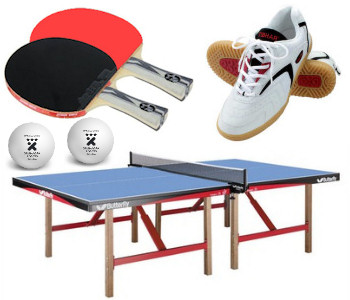
Click here for a large selection of
table tennis equipment at Bribar *
Here's how I learnt the basic skills...
In the beginning
When I started playing table tennis as a junior, I was fortunate enough to be able to go to regular table tennis coaching classes.
At those coaching sessions we used three table tennis tables - one table for beginners, one for intermediates and one for the top players.
This in itself was a good motivator and I was able to make my way from the beginners table to the top table in a short period of time.
TABLE TENNIS EXPERT
REVEALS HIS SECRETS
Click Here For Details

Click here for a large selection of
table tennis equipment at Megaspin *

Click here for a large selection of
table tennis equipment at Bribar *
^ Top of page ^
We had one...
Head Coach
We had one Head Coach who controlled the sessions, plus one experienced coach on each table who was able to "feed" the ball to us so that we could learn the required table tennis skill and practice our strokes.
One of the things I remember most about those coaching sessions is that, before we could start playing, we had to do warm up exercises.
At the time, being juniors who never worried about injuries etc, we all thought they were a waste of time - we just wanted to play!
Of course, I now know different.
^ Top of page ^
So we did...
Warm ups
Before you play, or take part in any table tennis coaching, you should always do warm up exercises. And it's important that you also do warm down exercises at the end of your session.
Warm up exercises should last for about 10 minutes.
The purpose of these is to ...
- Raise your body temperature
- Raise your pulse rate and
- Stretch the major muscle groups to be used in the lesson
Warm down exercises should also last for about 10 minutes.
The ideal warm down will...
- Decrease your body temperature and heart rate
- Help clear the lactic acid build up in muscles (lactic acid contributes to muscle soreness)
- Stretch out muscles after they've been contracting continually during the session
Our warm up exercises consisted of rotating wrist and neck muscles, rotating the trunk and stretching arm and leg muscles, jogging sideways, forward jogging and then running.
Then we'd progress to what we really wanted to do ... play table tennis.
Each session, our coaches would teach us new table tennis skills and we'd have the chance to practice new strokes.
^ Top of page ^
But what we were aiming for was the...
3 Table Tennis Skill Level Tests
When our coaches decided that we'd mastered the necessary table tennis skill, we were given the chance to take our junior proficiency award badges.
I remember that these were very important to us at that time.
However, the tests we took are useful for beginners at any age.
Our first table tennis skill challenge was the Bronze award.
^ Top of page ^
We had to take the following table tennis skill tests in order to qualify for our...
Bronze Junior Proficiency Award
See diagram below for "Target Areas"
- Slow Backhand Push
Using sound footwork, play 40 slow backhand push strokes back to Area B.
The controller will play, slowly, from Area B, alternately to Area C and Area D.
Requirement: 40 successes before 6th error.
- Slow Forehand Topspin Roll
Play 40 slow forehand topspin roll strokes back to Area A, without increasing speed.
The controller will play gentle returns from Area A to Area C.
Requirement: 40 successes before 6th error.
- Combined Control - Backhand Push and Forehand Roll
Return 40 slow balls from the controller by playing, in strict alternation, a backhand push and forehand roll, maintaining direction on 1 diagonal only.
Requirement: 40 successes before 6th error.
- Backhand Block
Against medium speed topspin from the controller, return the ball using backhand block strokes, from the peak-of-bounce position, maintaining direction on 1 diagonal only.
Requirement: 40 successes before 6th error.
- Short-Touch Services - Forehand and Backhand
From the correct position behind the baseline, serve a short forehand service so as to bounce twice in your opponent's court.
Required: 4 successes to be achieved within 8 attempts.
From the correct position behind the baseline, serve a short backhand service so as to bounce twice in your opponent's court.
Requirement: 4 successes to be achieved within 8 attempts.
- Long Top-Spin Services - Forehand and Backhand
From the correct position, serve a long forehand topspin service so that the ball lands within 18 inches of your opponent's baseline.
Requirement: 5 successes within 8 attempts.
From the correct position, serve a long backhand topspin service so that the ball lands within 18 inches of your opponent's baseline.
Requirement: 5 successes within 8 attempts.
Table Tennis Skill Target Areas:
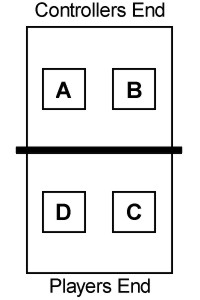
If, after further table tennis coaching, our coaches thought that we'd achieved the required table tennis skill, and we'd successfully completed our Bronze proficiency award badge ...
^ Top of page ^
We moved onto take the tests for the...
Silver Junior Proficiency Award
See diagram above for "Target Areas"
- Return of Service by half-volley
Forehand
Using forehand half-volley touch, return safely 10 services, varied as to topspin and chop and sidespin.
Backhand
Using backhand half-volley touch, return safely 10 services, varied as to topspin and chop and sidespin.
Requirement: 20 successes (10 + 10), before 6th error.
- Combining Drive and Push
Forehand
Return 40 balls, which have been alternately pushed and chopped by the controller to Area C, by alternately using forehand topspin drives and forehand push shots, back to Area A.
Requirement: 40 correct before 6th error.
Backhand
Return 40 balls, which have been alternately pushed and chopped by the controller to Area D, by alternately using backhand topspin drives and forehand push shots, back to Area B.
Requirement: 40 correct before 6th error.
- Combining (backspin) defensive returns with push
Forehand
Return 40 balls, which have been alternately driven and pushed by the controller to Area C, by alternately using forehand (backspin) defensive returns and forehand pushes, back to Area A.
Requirement: 40 correct before 6th error.
Backhand
Return 40 balls, which have been alternately driven and pushed by the controller to Area D, by alternately using backhand (backspin) defensive returns and backhand pushes, back to Area B.
Requirement: 40 correct before 6th error.
- Laws, Rules, etc ...
Answer 10 "everyday" questions on Laws and match procedure.
Points allowed: For complete answer 3; for correct "sense" 2; for part answer 1.
Pass score: 22 out of 30.
- Maintaining attack against topspin
Maintain 10 triple sequences of 2 forehand drives plus 1 backhand block
Required: 10 good sequences before 5th error.
Maintain 10 triple sequences of 2 backhand drives plus 1 forehand block
Requirement: 10 good sequences before 5th error.
- Service Variation
Deliver 10 services of varying length, incorporating sidespin, alternately left and right.
Requirement: 3rd error fails.
^ Top of page ^
Any player who reached an advanced table tennis skill level as a junior, could take the ultimate test...
Gold Junior Proficiency Award
See diagram below for "Target Areas"
- Topspin drives under pressure - Forehand
Play 50 forehand topspin drives, to one point, against half-volley returns which have been placed alternately to Areas C and D.
Good forehand position and footwork required throughout.
Requirement: 50 correct before 5th error.
- Topspin drives under pressure - Backhand
Play 50 backhand topspin drives, to one point, against half-volley returns which have been placed alternately to Areas C and D.
Good backhand position and footwork required throughout.
Requirement: 50 correct before 5th error.
- Counter-Driving, close and distant - Forehand
Return 20 counter-drives by means of forehand counter-drives in sequences of 2:
2 close, 2 distant, 2 close, etc. All returns kept on the same line.
Requirement: 3rd error fails.
- Counter-Driving, close and distant - Backhand
Return 20 counter-drives by means of backhand counter-drives in sequences of 2:
2 close, 2 distant, 2 close, etc. All returns kept on the same line.
Requirement: 3rd error fails,
- Combining Forehand and Backhand topspin drives
Against slow backspin returns, which have been placed alternately to Area J and K, play 20 forehand and backhand topspin drives, alternately, directed diagonally to Areas F and G.
Requirement: 3rd error fails.
- Combining Forehand and Backhand Defensive Backspin Returns
Return 20 drives, received alternately to Areas J and K, alternately using forehand and backhand backspin returns to Area L.
Requirement: 3rd error fails.
- Sequences of Topspin and Backspin Strokes
Play 15 double sequences of forehand backspin and backhand drive against balls which have been respectively driven to the forehand and pushed to the backhand.
Requirement: 4th error fails.
- Sequences of Topspin and Backspin Strokes
Play the reverse of (g), i.e. Backhand for Forehand(and vice versa).
Requirement: 4th error fails.
- Backhand Attack Distribution
Play 10 triple sequences:
- Dropshot to Area E
- Backhand drive to Area F
- Backhand drive to Area G
and repeat etc.
Controller returns all balls to Area H, from long distance, with backspin.
Requirement: 4th error fails.
- Loop-Topspin Forehand
Player to demonstrate loop drive 5 times against backspin returns of suitable length and strength, to suit his requirements.
The aim is to show understanding of the "loop" technique and a continuity of loop drives is not demanded.
Table Tennis Skill Target Areas (Gold):
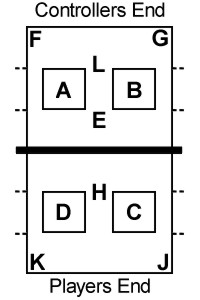
^ Top of page ^
Notes about table tennis skill tests:
- If a player uses a penhold grip, for "backhand" read "to the left of the body".
- If a player is left handed, reverse the targets A for B etc.)
- Players should be allowed to warm-up.
- Assessors are responsible for arranging: (a) Suitable Controllers to give each player a fair chance, and
(b) a Scorer, to keep count of successes and errors.
- The Controller should be a player able to place slow and steady balls to required targets, with the required spin.
Mistakes by the Controller, or unlucky balls, or balls which are not appropriate to the required test skill, will not be counted against the player.
- Assessors will rule on quality of performance appropriate to each test level.
A push shot is a return which is low, slow, and straight, with a trace of backspin.
- Appropriate Target Areas are shown in the diagram.
Since the aim of Proficiency Awards is to train players to maintain control of length and direction,
the Assessor should require good consistency in these respects, but allow for difficulties caused by inconsistent
feeding from the Controller, or difficult playing conditions. If the exchanges become difficult it is fairer to call a let,
and re-start from the score already reached.
- Target Areas may be regarded as a notional 18 inches square. They need not be marked out in full.
A, B, C, D are the centre points of the four courts.
Two sheets of A4 paper can form a useful approximation of these Centre Areas when rehearsing the tests.
So, I recommend that you use the above skill tests to improve your table tennis skill level.
^ Top of page ^
| MORE PAGES ABOUT HOW TO PLAY TABLE TENNIS |
|---|
For more information on how to play table tennis and improve your game, take a look at my other tips and techniques articles...
Basic Skills
Advanced Skills
Strategies and Tactics
Tips
Skill Tests
Exercises
E-Books
|
Click here for a large selection of
table tennis equipment at Megaspin *

Click here for a large selection of
table tennis equipment at Bribar *
^ Top of page ^
You Are Here: Home » How to Play Table Tennis » Skill Tests
